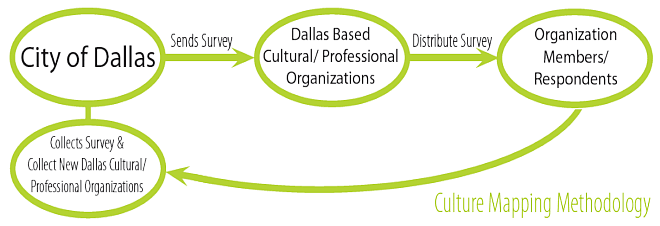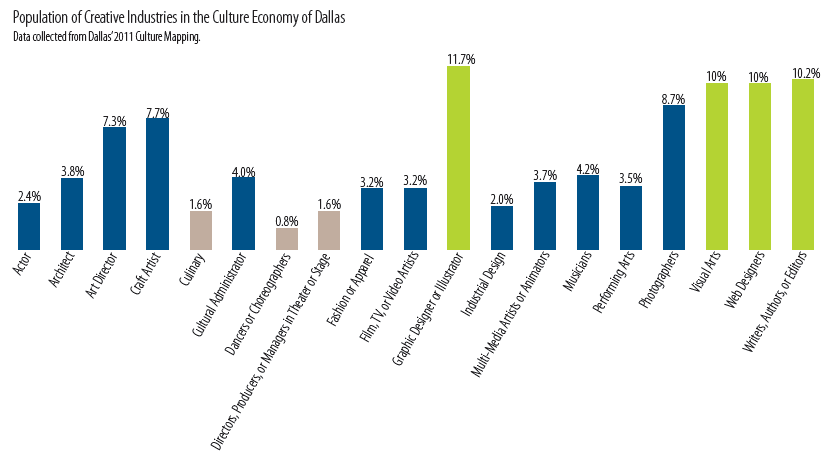WHAT IS CULTURE MAPPING?
The City of Dallas is embarking on a new project to map the cultural economy within its borders. A process that will identify and help create new opportunities that add to Dallas’ cultural richness. The process, known as culture mapping, has been done in only a few major cities in the US. Dallas is one of the first Cities to spotlight its cultural economy in this method. This process will identify where the cultural economy coalesces and how they stay connected to their communities.
Mapping the cultural economy in Dallas highlights new opportunity for the City, creative industries, local organizations and culture producers in that economy. The City, its businesses and citizens, can best locate, advertise, and utilize the skills of the local cultural economy only if they know who and where they are. Culture mapping informs industries, who only adjust and grow if they know where their markets and institutions are, by mapping those locations on a macro scale of the city. Organizations can better interconnect, grow their member base, and expand their project loads by better understanding the relationship of where their members live and work. Culture Mapping locates where people live and work, identify organizations involvement with each other and how to contact new partners. Culture producers can learn if there is a market to be tapped, an area of like-minded individuals, and organizations to help them bring their ideas to fruition. All these opportunities for growth and strengthening tthe City of Dallas come from this process.
This website helps illuminate the current state of the cultural economy within the City of Dallas. The process should be repeated annually to grew in respondent size, catalogue the change in the cultural economy, and to continue to highlight opportunities for an important portion of the economy that makes Dallas unique and vibrant.
METHODOLOGY
Dallas City Design Studio staff developed an online survey through the online tool, Survey Monkey ©. The survey was modeled after a segment of questions within the Creative New York Report by the Center for an Urban Future and the Mt. Auburn Associates. A twelve question survey was adapted and tested in house with a “mini-survey” approach of 22 people, ensuring the questions were comprehended. A list was compiled by staff of local and professional organizations within the creative economy. This list was gathered through research over three days to ensure every field was adequately represented.

WHAT ARE THE FIELDS THAT MAKE UP THE CULTURAL ECONOMY OF DALLAS?
A collection of creative industries make up the cultural economy. These industries were originally settled on by John Howkins in the earliest part of this century. The industries were advertising, architecture, art, crafts, design, fashion, film, music, performing arts, publishing, research, development, software, games, and tv and radio. Over time new industries have formed, web development, while others have merged, research and development. The most current standard of what industries comprise the cultural economy are reflected in culture mapping in other cities, New York. For this first Culture Mapping undertaking within the City of Dallas the following cultural industries have been chosen to represent the total cultural economy: actor, architect, art director, craft, artist, culinary, cultural administrator, dancers, choreographers, directors, producers, managers, theater, stage, fashion, apparel, film, tv, video artists, graphic designer, illustrator, industrial design, multi-media artists, animators, musicians, performing arts, photography,visual arts, web design, writers, authors, and editors.
The City of Dallas’ highest concentration of respondents identified themselves in the categories of “Graphic Design or Illustration”, “Visual Arts”, “Web Designers, and “Writers, Authors, or Editors.” While we see the lowest number of respondents identified themselves in the categories, “Culinary”, “Dancers, Choreographers,” and “Directors, Producers, or Managers in Theater or Stage.”

